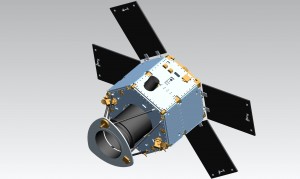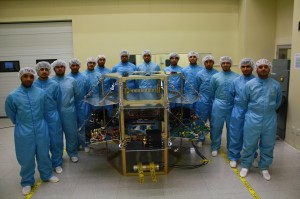- UAE’s second remote sensing satellite to be launched in end-2012
- His Highness Sheikh Mohammed bin Rashid’s commitment to develop UAE youth is real achievement, says Al Mansoori
 The Emirates Institution for Advanced Science & Technology (EIAST) revealed the final design details and specifications of its second satellite project, DubaiSat-2. At a press conference held in Dubai today, UAE engineers working on the project shared the details of DubaiSat-2, the UAE’s second remote sensing satellite due to be launched into orbit by the end of 2012.
The Emirates Institution for Advanced Science & Technology (EIAST) revealed the final design details and specifications of its second satellite project, DubaiSat-2. At a press conference held in Dubai today, UAE engineers working on the project shared the details of DubaiSat-2, the UAE’s second remote sensing satellite due to be launched into orbit by the end of 2012.
“Our investment in the UAE team of engineers is the most important achievement of EIAST through our flagship satellite, DubaiSat-1, launched in 2009. This reflected the vision of His Highness Sheikh Mohammed Bin Rashid Al Maktoum, UAE Vice President & Prime Minister and Ruler of Dubai, to strengthen the involvement of UAE youth in frontier and advanced sciences. These young engineers and specialists are now more confident and determined to succeed as they work towards the launch of DubaiSat-2 late next year, and this is the real achievement of our space programme,” said Ahmed Al Mansoori, Director General, EIAST.
 “The DubaiSat-2 project is in line with the aspirations of our leadership to promote the knowledge base and technical skills of UAE nationals, enabling them to embrace the latest technologies which will contribute to the overall social and economic growth of the UAE. The leadership also envisions the creation of a knowledge-based economy by developing our human resources,” he added.
“The DubaiSat-2 project is in line with the aspirations of our leadership to promote the knowledge base and technical skills of UAE nationals, enabling them to embrace the latest technologies which will contribute to the overall social and economic growth of the UAE. The leadership also envisions the creation of a knowledge-based economy by developing our human resources,” he added.
The technical improvements of DubaiSat-2 include an increase in the speed of the data download from 30 Mbit / second, as is the case in DubaiSat-1, up to 160 Mbit / second, in addition to increasing the amount of data acquired by the satellite per day from 12,000 square metres to 17,000 square metres. With these technical improvements, the weight of the satellite is now 300 kg and its size is two metres in height and 1.5 metres wide.
The orbital height of the satellite has been modified to 600 km above the earth’s surface compared to 690 km, which is the current orbit of DubaiSat-1. The orbit has also been changed from an ascending obit (South to North)_ to a descending orbit (North to South), which will allow both satellites to work well in constellation as well as give better coverage over the UAE area.
Among other significant improvements, the UAE team along with their South Korean Partners (Satrec Initiative) has designed the satellite to produce higher quality images of the world. The satellite will have a panchromatic resolution of 1m and a multispectral resolution in of 4m in four spectral bands (Red, Green, Blue and Near Infrared). This would enhance the quality of the images for various applications including environmental projects, urban planning, infrastructure, telecommunications and electricity.
DubaiSat-1 was also a joint project between the UAE and South Korea, and during its development the focus was on knowledge transfer to the UAE team and its participation in building the satellite. With DubaiSat-2, the UAE team is involved in a joint development project with the South Koreans, in which the UAE is participating in all aspects of the design, development, manufacturing and eventual launch. This joint development has led the team to produce one of the best performing satellite in the 300 kg class.
Salem Al Marri, Head of Space Programme Department at EIAST, said: “The UAE team of engineers benefited from their first experiences with DubaiSat-1 as they learnt more about satellite systems development. By drawing on that experience, they have made significant contributions to DubaiSat-2. Their involvement marks the giant stride that the UAE has made in the path of scientific research and technical progress.”
The Emirates Institution for Advanced Science & Technology EIAST has signed a contract with the International Space Company Kosmotras (ISCK) from Russia to launch DubaiSat-2. It will be launched on board a Dnepr Rocket through the Moscow-based International Space Company Kosmotras (ISCK) from Yasny Cosmodrome in Russia by the fourth quarter of 2012, as part of a clustered launch, in which DubaiSat-2 will be the primary satellite on board.
Engineer Omran Anwar Sharaf, Deputy Head of Space Programme Department at EIAST, said: “The second experience in developing a satellite gave us more confidence about the various techniques involved. The UAE engineers have acquired experience and knowledge that will enable them to initiate UAE projects to serve the country in the field of space and satellite manufacturing.”
 The DubaiSat-2 project is a joint development programme between EIAST and Satrec Initiative of South Korea, in which 16 UAE engineers have been working on the design, development, testing and manufacturing of the satellite. The participation of the UAE engineers who are currently working in South Korea has increased by 100 per cent from the DubaiSat-1 project and it is hoped this will take EIAST to the next level in satellite development.
The DubaiSat-2 project is a joint development programme between EIAST and Satrec Initiative of South Korea, in which 16 UAE engineers have been working on the design, development, testing and manufacturing of the satellite. The participation of the UAE engineers who are currently working in South Korea has increased by 100 per cent from the DubaiSat-1 project and it is hoped this will take EIAST to the next level in satellite development.
Engineer Amer Al Sayegh, Deputy Head of Space Programme Department at EIAST, said that DubaiSat-2 is set apart by the significant growth in the participation of UAE engineers in the project. They are involved in developing solutions, techniques and advanced research, thus contributing directly to the design and applications, in addition to enhanced co-operation with international institutions such as the Japanese Space Agency for introducing new techniques in the satellite.
EIAST had launched DubaiSat-1 in July 2009, and since then the satellite has been transmitting images that are of great value in several areas. Its relatively high spatial resolution complements existing Geographic Information System (GIS) databases and enables more efficient monitoring of various environmental changes, and managing natural hazards, in addition to identifying the quality of water in the Gulf region.






















![The Square at Nad Al Sheba Gardens Now Open hope tax season treated you well! Just checking in—ready to refocus on growing your business? I remember how we discussed scaling your [specific aspect of their business, e.g., online presence] but paused due to time constraints. We now offer a streamlined 6-month plan that delivers real results without adding to your workload. Let me know if you'd like to chat—I’d love to help you pick up where we left off!](https://www.dubaichronicle.com/wp-content/uploads/2024/11/The-Square-5-218x150.jpg)









